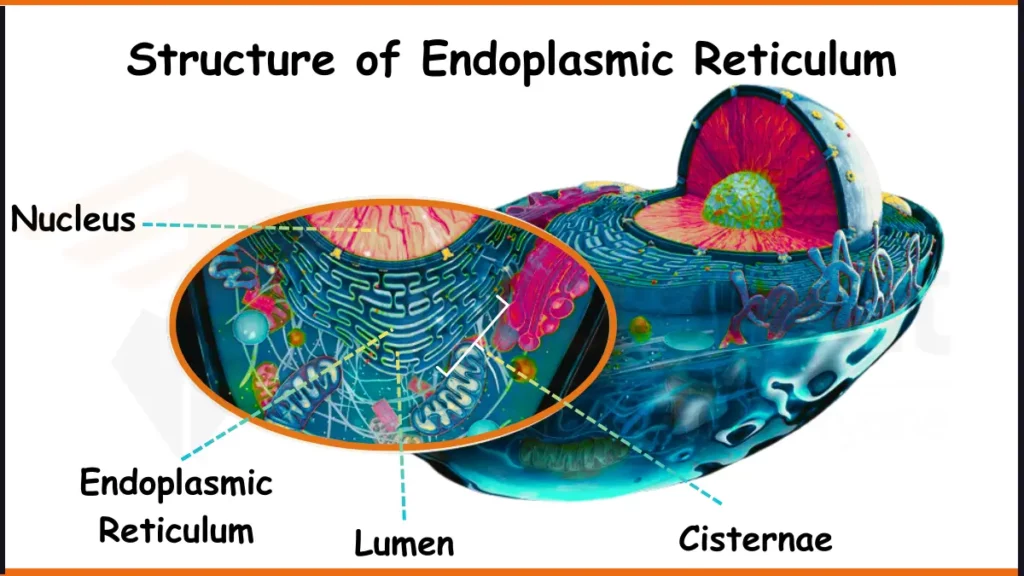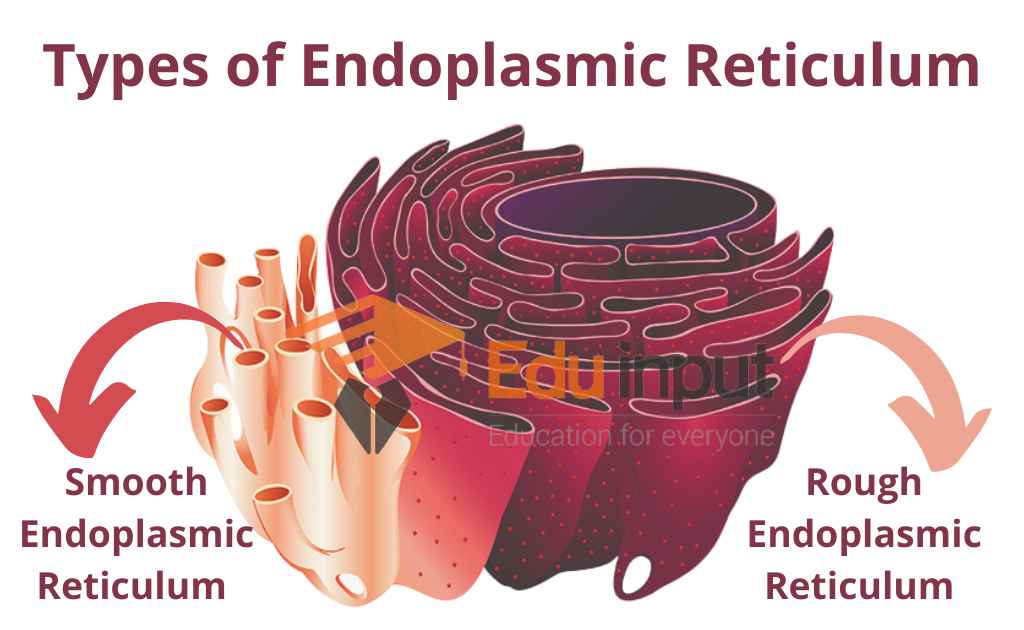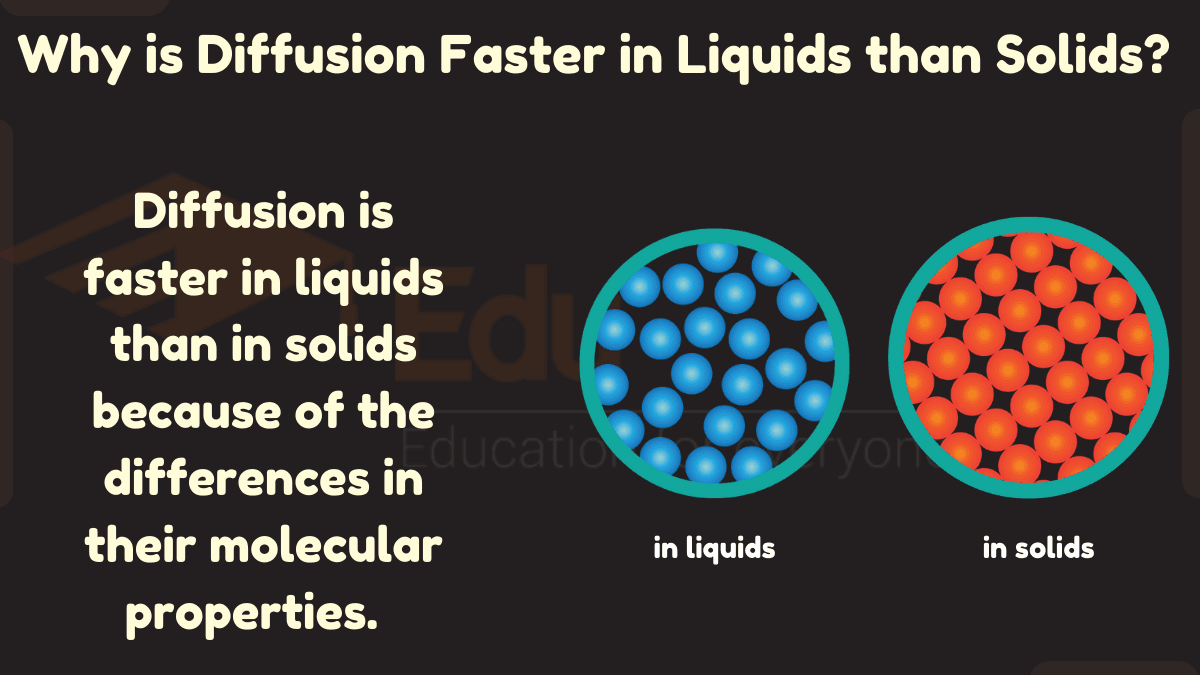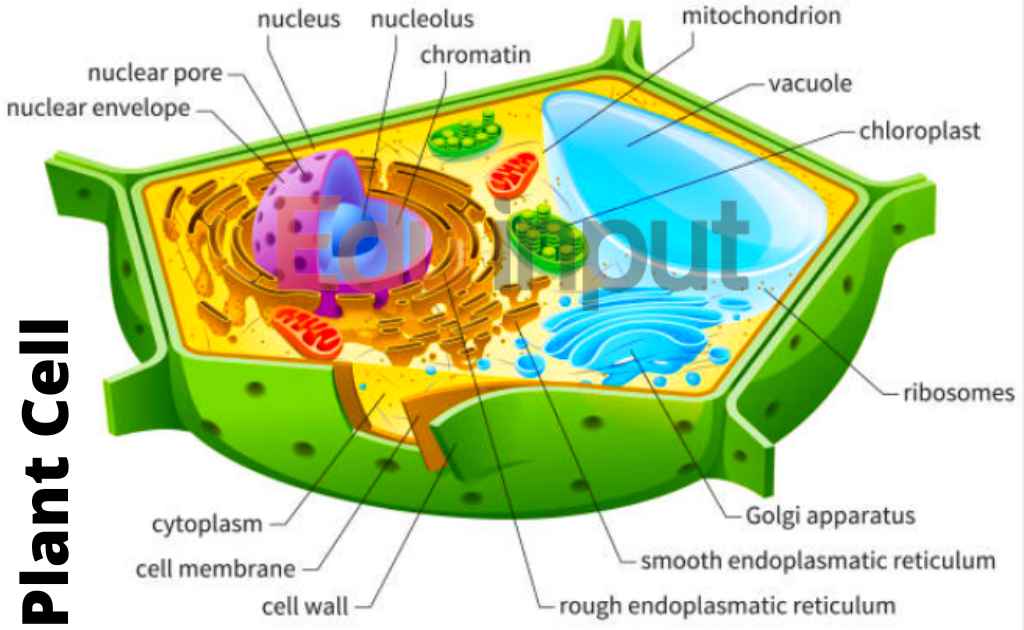Endoplasmic Reticulum – Structure, Types, and Functions
The endoplasmic reticulum (ER) is an extensive network of membranous tubules and flattened sacs called cisternae that extend throughout the cytoplasm of eukaryotic cells. They are also in contact with the nuclear membrane. This entire system of channels is the endoplasmic reticulum.
The word reticulum means “network. The Endoplasmic Reticulum (ER) is located within the cytoplasm of eukaryotic cells.

History of Endoplasmic Reticulum
The ER was observed for the first time in the late 19th century when studies of stained cells indicated the presence of an extensive cytoplasmic structure. Here is timeline of History of Endoplasmic Reticulum:
- 1897: Edouard G. Gardiner observed a network of membranes within cells using light microscopy and coined the term “ergastoplasm,” laying the groundwork for future discoveries.
- 1902: Emilio Veratti described a similar network in muscle fibers, terming it the “sarcoplasmic reticulum.” While significant, it wasn’t yet recognized as a universal cellular structure.
- 1945: A breakthrough arrived with the invention of the electron microscope. Keith R. Porter, Albert Claude, and Ernest F. Fullam used this powerful tool to finally visualize the ER’s intricate network of membranes in detail across various cell types.
- 1953: Keith Porter built upon the 1945 discovery by coining the now-familiar term “endoplasmic reticulum.” “Endoplasmic” refers to its location within the cell (endoplasm), and “reticulum” describes its net-like structure.
Structure of Endoplasmic Reticulum
Endoplasmic Reticulum has a unique structure that allows it to perform various functions in the cell. The structure of the endoplasmic reticulum can be described as following parts:

- Membrane system – The endoplasmic reticulum is a membrane-bound organelle, consisting of a continuous network of flattened sacs (cisternae) and tubules. The membrane of the ER is a phospholipid bilayer, similar to the structure of other cellular membranes.
- Ribosomes – The rough ER (RER) is characterized by the presence of ribosomes attached to its cytoplasmic surface. These ribosomes are responsible for the synthesis of proteins that are either destined for secretion or incorporation into the membrane of the ER itself or other organelles.
- Lumen – The interior space of the ER is called the lumen or cisternal space. The lumen of the ER is continuous with the lumen of the nuclear envelope, as the ER is an extension of the nuclear envelope.
- Membrane proteins – The ER membrane contains various proteins that are involved in different functions, such as protein folding, protein transport, and enzymatic activities.
- Transitional ER – This region of the ER is involved in the transport of newly synthesized proteins from the rough ER to the Golgi apparatus. It is characterized by the presence of small vesicles that bud off from the ER and move toward the Golgi complex.
- Tubular network – The ER forms a continuous, interconnected network of tubules that extends throughout the cytoplasm. These spherical or tubular membranes are called Cisternae. This network allows for efficient transport of materials and communication between different regions of the cell.
Types of Endoplasmic Reticulum
There are two forms of the endoplasmic reticulum. These are:

1. Smooth Endoplasmic Reticulum
The cytoplasmic surface of the SER lacks ribosomes. So they are known as SER. SER of various cell types functions in diverse metabolic processes like the synthesis of lipids, carbohydrate metabolism, the detoxification of drugs, and other poisons.
Functions of SER
Here are some main functions of the Smooth Endoplasmic Reticulum:
1. Lipid Synthesis
The SER plays a vital role in the synthesis of lipids, including phospholipids and cholesterol. These lipids are essential components of cell membranes and serve various other functions within the cell.
2. Detoxification
The SER is involved in the detoxification of harmful substances. It contains enzymes that catalyze reactions to break down toxic compounds, making them less harmful or easier to excrete.
3. Calcium Storage and Regulation
The SER serves as a storage site for calcium ions (Ca2+). It can release or sequester calcium ions, which are important for various cellular processes, such as muscle contraction and signal transduction.
4. Steroid Synthesis
In specialized cells, such as those in the gonads and adrenal glands, the SER is responsible for the synthesis of steroid hormones, including estrogen, testosterone, and cortisol.
5. Metabolism of Carbohydrates
The SER plays a role in the metabolism of carbohydrates, particularly in liver cells. It is involved in the process of gluconeogenesis, which is the synthesis of glucose from non-carbohydrate precursors.
6. Transmission of Nerve impulses
SER transmit nerve impulse in some cells like muscles and nerve cells.
7. Transport of material
The SER plays an important role in the transport of material within the cell.
8. Mechanical Support
The endoplasmic reticulum provides mechanical support to the cell. So the shape of the cell is maintained.
2. Rough Endoplasmic Reticulum
It is named for its rough appearance because of the attached Ribosome. Ribosomes are attached to the cytoplasmic surface of the membrane of RER.
So RER appears rough through an electron microscope. Rough ER lies adjacent to the nucleus of the cell. Its membrane is continuous with the outer membrane of the nuclear envelope.
Functions of RER
RER performs the following functions in the cell:
1. Protein Synthesis
Specialized cells secrete proteins produced by the rough ER. For example, white blood cells secrete antibodies. Proteins are synthesized by ribosomes attached to the rough ER.
The polypeptide chain grows and enters through the ER membrane into the cisternal space. The protein enters the cisternal space and it is folded. Secretary proteins are glycoproteins. Proteins are covalently bonded to carbohydrates in SER.
The secretory proteins are wrapped in the membranes of vesicles. They sprout from a particular region called the ER. These vesicles are named transport vesicles
2. Membrane Production
Rough ER is a membrane factory. It grows through the addition of proteins and phospholipids. They are added to the ER membrane itself. The enzymes present in the RER synthesized their membranes from these phospholipids and proteins. The ER membrane can be transferred to the plasma membrane in the form of vesicles.
3. Protein Folding and Modification
The RER plays a crucial role in the folding and modification of proteins. Enzymes within the RER assist in the proper folding and addition of carbohydrate groups (glycosylation) to certain proteins.
4. Protein Sorting and Transport
The RER is responsible for sorting and transporting proteins to their correct destinations. Proteins destined for secretion or integration into cellular membranes are packaged into transport vesicles that bud off from the RER.
Difference Between Smooth Endoplasmic Reticulum and Rough Endoplasmic Reticulum (SER vs RER)
| Smooth Endoplasmic Reticulum | Rough Endoplasmic Reticulum |
| Ribosomes are absent. | Ribosomes are present. |
| present near the plasma membrane. | Present near the nucleus, adjacent to the nuclear envelope |
| Composed of the tubules. | Composed of the cisternae. |
| Helps in the synthesis of glycogen, lipids, and steroids. | It participates in the synthesis of enzymes and proteins. |
| Provides vesicles for cis-face of the Golgi apparatus. | Provides proteins and lipids for the Golgi apparatus |
| It gives rise to spherosomes / oleosomes | It helps in the formation of lysosomes. |
| It is develops from the rough endoplasmic reticulum. | It might get developed from the nuclear envelope. |
Frequently Asked Question-FAQs
What is the main function of Endoplasmic Reticulum?
The main function of the Endoplasmic Reticulum is to synthesize proteins for the cell. It contain ribosomes, that are the factories of proteins.
What is smooth Endoplasmic Reticulum (SER)?
The smooth endoplasmic reticulum is a type of endoplasmic reticulum that is without ribosomes. Thus they are not involved in protein synthesis and provide aid in lipid synthesis.
What are the types of Endoplasmic Reticulum?
There are two types of Endoplasmic Reticulum;
Smooth Endoplasmic Reticulum-SER
Rough Endoplasmic Reticulum-RER
Does the Endoplasmic Reticulum contain DNA?
No, Endoplasmic Reticulum does not contain DNA. Chloroplast, Nucleus, and mitochondria are the cellular organelles that contain their DNA.







Leave a Reply